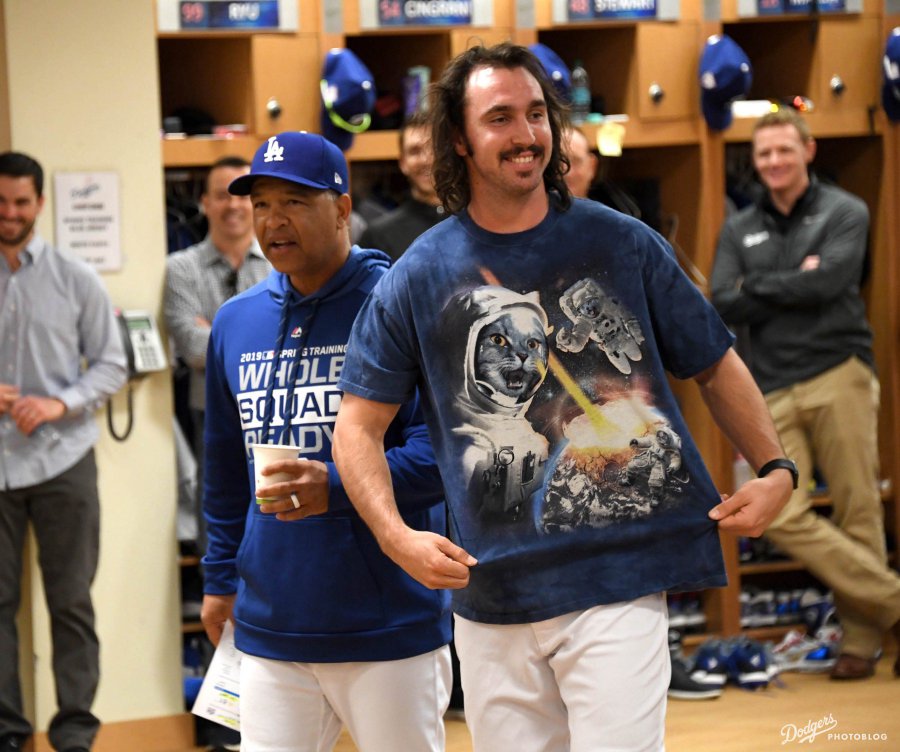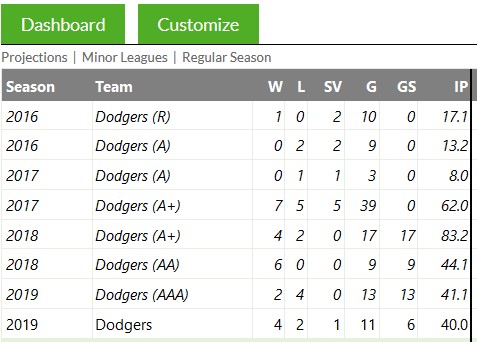With the offseason dragging on and very little happening (at least that would be enjoyable for me to write about), I am nearly out of ideas. So here’s the result of my boredom looking through last year’s stats: Tony Gonsolin’s somewhat odd numbers from 2019.
——
When I originally started researching numbers for this, it was while assuming Gonsolin may have a prominent role in the Dodgers’ rotation. Now that Jimmy Nelson and Alex Wood have been added to the roster, albeit with contracts that include incentives should they end up in the bullpen (sorry Kenta Maeda), Gonsolin moved down the list of prospective starters in 2020.
Before getting too deeply into it, I’ll admit I have no idea what to make of Gonsolin. He’s clearly intriguing as he’s ranked well among the organization’s prospects for a reason and throws a pitch only 40 pitchers moderately use 25% of the time. Couple that with the hair, mustache and Caturday thing, and you have a fun guy to cheer for (at least from my perspective).
But really, Gonsolin’s professional career thus far is an odd one when taking a closer look. Since being drafted in the 9th round of the 2016 draft, Gonsolin has thrown 310 1/3 innings. Admittedly, a large part of that is the Dodgers using him as a reliever through his first two professional seasons which equaled 101 innings between Ogden, Great Lakes and Rancho.
That’s part of why taking a look at Gonsolin rather than Dustin May is more interesting. May’s started at every level and already pitched more than 400 innings since going in the same draft as Gonsolin. More so, May is only entering his age-22 season while Gonsolin is already 26 this spring. Somehow, Wood is barely three years older than Gonsolin.
The Basics
While May’s ERA (3.63), xFIP (3.70) and SIERA (3.79) across 34 2/3 innings in the majors gives a pretty clear picture of how he performed, Gonsolin’s numbers are all over the place. A 2.93 ERA was contradicted by a 4.90 xFIP and a 4.63 SIERA in his 40 innings. Not great.
Down in Triple-A, Gonsolin’s ERA/FIP/xFIP was an even worse 4.35/4.38/5.94 in 41 1/3 innings (there’s no SIERA data for the minors on FanGraphs.) What brought along the huge discrepancy? Well in the majors a .208 BABIP likely helped out the 2.93 ERA a bit, as it was the lowest, by far, he’s produced at any level in his professional career. And while some numbers are going to inevitably drop as the competition increases, Gonsolin’s BB% in Los Angeles and OKC easily topped any other stop in his career while his K% dropped lower than every professional season besides the first.
Potentially a reason for Gonsolin’s heightened walk rate was his ability to throw strikes early in the count. He finished at just 59.5% of first-pitch strikes while in the majors, ranking 256th of 398 pitchers with at least 40 innings. Similarly, his 9.2% BB% tied for 266th in the same total qualifiers. And of course, the HR/FB rate rose to 8.5%, higher than any stop besides an 8-inning stint in Low-A back in 2017.
Weird Sample Sizes
The issue with nearly all of these numbers is how small the sample was at just about every stop in Gonsolin’s rise through the Dodgers organization. Here they all are:
The 41 1/3 innings in Triple-A this year was his only time at the level while the 44 1/3 innings at Double-A in 2018 were the same case. The Dodgers, and others, clearly think highly of him as he’s been on a quick rise since leaving Rancho in July 2018. Yet he’s only started 45 games as a professional.
So while Gonsolin’s GB% increased and his LD% dropped to rates ranking among the best of his career while in Los Angeles, I’m not entirely sure how much it matters yet. Gonsolin is likely going to start some games for the Dodgers in 2020, as he should. But as always, the Dodgers being sure to build some depth looks pretty crucial in case Gonsolin needs some more work (or a role in the bullpen).
Pitch Selection
As I alluded to earlier, Gonsolin’s use of a splitter lands him among a dying breed. According to Baseball Savant 38 pitchers threw a splitter at least 10% of the time in 2017. In 2019, it was down to 31 (out of 709 pitchers) with Gonsolin’s 25.1% usage ranking him 14th.
The spin rate on Gonsolin’s splitter ranks sixth at 1,998 rpm, and breaks toward right-handed batters at a higher rate than average (8th in horizontal movement), but drops at the second-lowest rate of the 31 pitchers listed. Gonsolin relied heavily on the pitch against left-handed batters, throwing it 30.1% of the time leading to a 32.7 Whiff%, 12 strikeouts and 6 hits in 34 PAs. Otherwise, Gonsolin threw his four-seamer 47.7% of the time to lefties with his curve (12.2%) and slider (9.2%) well behind.
That Gonsolin splitter is 🔥🔥 https://t.co/Pty7y3lOy3
— Dustin Nosler (@DustinNosler) March 11, 2019
Understandably, the usage switched against righties with the splitter dropping off and the slider moving up. Still at 48.1% four-seamers, Gonsolin’s slider jumped to 25.6% against right-handers and produced a 46.7 Whiff%, six strikeouts and just one hit in 18 PAs. The splitter still succeeded against righties while used 18.5%, finishing at 47.4 Whiff%, five strikeouts and two hits in 14 PAs. The curve made up the other 7.7% of pitches to right-handed batters.
A few other extremes to note in Gonsolin’s pitch movement were his 314th of 334 pitchers in vertical slider movement while also sitting 270th in horizontal movement. The 88 mph average left Gonsolin 38th among pitchers. Interestingly, the Dodgers’ Dylan Floro ranked pretty similarly to Gonsolin in all three categories. Gonsolin’s four-seamer spin rate (2,456 rpm) also ranks above average, but the pitch’s velo and movement are mostly league average.
——
Anyway, all of those factors lead to Gonsolin being a bit of an oddity and difficult to predict. Due to his unknown role heading into 2020, it doesn’t seem likely that clarity will be found this year either, but he’s definitely a pitcher to watch carefully because of it.
 Dodgers Digest Los Angeles Dodgers Baseball Blog
Dodgers Digest Los Angeles Dodgers Baseball Blog

